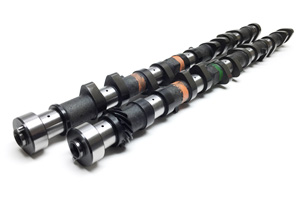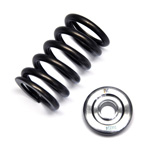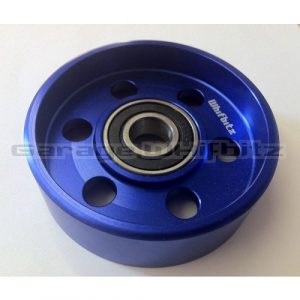Description
1JZ-GTE VVTi CAMSHAFTS 9.52/9.65
Race Specification
Longer duration profile, added rpm potential. Intended for fully built engine. Tuning and ECU mods recommended, requires uprated valve springs.
The third generation of the 1JZ-GTE was introduced around 1996, still as a 2.5-litre turbo, but with Toyota’s BEAMS architecture.[2] This included a reworked head, newly developed continuously variable valve timing mechanism (VVT-i), modified water jackets for improved cylinder cooling and newly developed shims with a titanium nitride coating for reduced cam friction.[3] The turbo setup changed from parallel twin turbo (CT12A x2) to a single turbo (CT15B). The single turbo is in part made more efficient by the use of smaller exhaust ports in the head, this allows the escaping exhaust gasses to have more velocity as they exit the head, which in turn, spools the turbo faster and at lower RPM. The adoption of VVT-i and the improved cylinder cooling allowed the compression ratio to be increased from 8.5:1 to 9.0:1. Even though the official power figures remained at 280 metric horsepower (210 kW) at 6200 rpm, torque was increased by 20Nm to 379 newton meters (280 lbs·ft) at 2400 rpm. These improvements resulted in increased engine efficiency that reduced fuel consumption by 10%. The adoption of a much higher efficiency single turbocharger than the twins as well as different manifold and exhaust ports were responsible for most of the 50% torque increase at low engine speeds . This engine was used primarily in Toyota’s X chassis cars (Chaser, Mark II, Cresta, Verossa), the Crown Athlete V (JZS170) and in the later JZZ30 Soarer, as the JZA70 Supra was long discontinued by this time.
Additional information
| Weight | 10.0000 kg |
|---|---|
| Brand | |
| Manufacturer Name |





 Civic
Civic  Integra
Integra  NSX
NSX  S2000
S2000  IS
IS  IS-F
IS-F 



 MX5
MX5  RX7
RX7  RX8
RX8  EVO
EVO  EVO X
EVO X  GTO
GTO  200SX
200SX  300ZX
300ZX  350Z
350Z  370Z
370Z  GTR
GTR  Pulsar
Pulsar  Skyline
Skyline  BRZ
BRZ  Forester
Forester  Impreza
Impreza 
 Aristo
Aristo  Celica
Celica  Chaser
Chaser  GR Corolla
GR Corolla  GR Yaris
GR Yaris  GR-86
GR-86  GT-86
GT-86  MR2
MR2  Soarer
Soarer  Starlet
Starlet  Supra A90
Supra A90  Supra MK4
Supra MK4 










